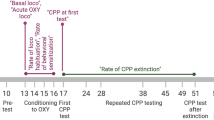Abstract
Tonic pain has been difficult to demonstrate in animals. Because relief of pain is rewarding, analgesic agents that are not rewarding in the absence of pain should become rewarding only when there is ongoing pain. We used conditioned place preference to concomitantly determine the presence of tonic pain in rats and the efficacy of agents that relieve it. This provides a new approach for investigating tonic pain in animals and for evaluating the analgesic effects of drugs.



Similar content being viewed by others
Change history
09 June 2010
In the version of this article initially published, a citation was inadvertently omitted. To correct this, “Attempts to measure the negatively reinforcing actions of MK-801, an NMDA receptor inhibitor, on chronic pain using CPP in a rat model of inflammation have been made, but the data were not conclusive 16” has been inserted following the first sentence in the fourth paragraph. A reference was also added to the reference list as follows: 16. Sufka, K.J. Pain 58, 355–366 (1994). The error has been corrected in the HTML and PDF versions of the article.
References
Backonja, M.M. & Stacey, B. J. Pain 5, 491–497 (2004).
Boulton, A.J.M. Clin. Diabetes 23, 9–15 (2005).
Rowbotham, M.C. Neurology 65, S66–S73 (2005).
Campbell, J.N. & Meyer, R.A. Neuron 52, 77–92 (2006).
Rice, A.S. et al. Pain 139, 243–247 (2008).
Vierck, C.J., Hansson, P.T. & Yezierski, R.P. Pain 135, 7–10 (2008).
Eisenach, J.C., Rauck, R.L. & Curry, R. Pain 105, 65–70 (2003).
Johansen, J.P., Fields, H.L. & Manning, B.H. Proc. Natl. Acad. Sci. USA 98, 8077–8082 (2001).
Skinner, B.F. The Behavior of Organisms (Appleton Century Crofts, New York, 1938).
Burgess, S.E. et al. J. Neurosci. 22, 5129–5136 (2002).
Martin, T.J., Kim, S.A., Buechler, N.L., Porreca, F. & Eisenach, J.C. Anesthesiology 106, 312–322 (2007).
Decosterd, I. & Woolf, C.J. Pain 87, 149–158 (2000).
Niikura, K. et al. Neurosci. Lett. 435, 257–262 (2008).
Ungless, M.A., Magill, P.J. & Bolam, J.P. Science 303, 2040–2042 (2004).
Fields, H. Nat. Rev. Neurosci. 5, 565–575 (2004).
Sufka, KJ Pain. 58, 355–366 (1994).
Author information
Authors and Affiliations
Contributions
T.K. was partly responsible for design, data analysis, interpretation, writing and editing of the manuscript and figures. L.V.-P. was partly responsible for data collection and analysis. T.G. contributed to the SNI experiments. T.W.V., G.D. and J.L. provided conceptual input to the design and interpretation of the experiments. H.L.F. and F.P. jointly conceived and designed the studies and contributed to the interpretation, writing and editing of the manuscript.
Corresponding author
Supplementary information
Supplementary Text and Figures
Supplementary Methods (PDF 82 kb)
Rights and permissions
About this article
Cite this article
King, T., Vera-Portocarrero, L., Gutierrez, T. et al. Unmasking the tonic-aversive state in neuropathic pain. Nat Neurosci 12, 1364–1366 (2009). https://doi.org/10.1038/nn.2407
Received:
Accepted:
Published:
Issue Date:
DOI: https://doi.org/10.1038/nn.2407
- Springer Nature America, Inc.
This article is cited by
-
A mesocortical glutamatergic pathway modulates neuropathic pain independent of dopamine co-release
Nature Communications (2024)
-
Differential Roles of the D1- and D2-Like Dopamine Receptors Within the Ventral Tegmental Area in Modulating the Antinociception Induced by Forced Swim Stress in the Rat
Neurochemical Research (2024)
-
An ACC–VTA–ACC positive-feedback loop mediates the persistence of neuropathic pain and emotional consequences
Nature Neuroscience (2024)
-
Neo-Cartesianism and the expanded problem of animal suffering
International Journal for Philosophy of Religion (2023)
-
Place conditioning in humans: opportunities for translational research
Psychopharmacology (2023)





